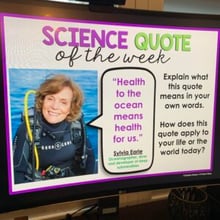Planets Activities for Middle School Science
The resources below will provide students a comprehensive understanding of the planets. All of the following lessons are also included in the Kesler Science Membership.
The Planets 5E Lesson includes materials for every "E" phase, including the Planets Station Lab for Exploration and an interactive PowerPoint with digital INB templates for Explanation.
The lesson also includes introduction materials for Engagement, student-choice project ideas for Elaboration, and assessments for Evaluation.
After completing the Planets 5E Lesson, students will be able to classify inner and outer planets, describe the characteristics of planets, and understand that gravity is the force that governs movement in the solar system.
The Planets Inquiry Lab is a hands-on activity that is differentiated for advanced, on-level, and modified middle school students.
Students will analyze the orbital distance and revolutionary period of planets in our solar system.
The Planets Inquiry Lab includes a brief reading passage, comprehension checks, hands-on activities, reflection questions, and a CER conclusion.
The Planets Sub Plan is a complete lesson that takes students through a warm-up, reading passage, independent activity, extension activities, and an assessment.
The worksheets are designed to make your sub day a breeze for you, your students, and the substitute teacher. They are also perfect for distance learning.
Planets Classroom Experiences
Create a powerful student experience to help solidify students' understanding about planets. All of the following experiences are also included in the Kesler Science Membership.
Escape Rooms
The Planets Escape Room is an immersive experience for your students. It allows them to classify inner and outer planets, describe the characteristics of planets, and understand that gravity is the force that governs movement in the solar system.
Students must use what they have learned to describe the physical properties, locations, and movements of the Sun, planets, moons, meteors, asteroids, and comets and develop and use a model to describe the role of gravity in the motions within galaxies and the solar system. They must also analyze and interpret data to determine scale properties of objects in the solar system to complete the escape room.
STEM CHALLENGES
The Project, Solar System Explorer - Build a Scale Model of Planets STEM Challenge uses the engineering design process to create a scale model of the distances between planets in the solar system.
Students will be using collaborative skills such as brainstorming with their peers and reflecting on their progress during the project.
At the end of the Project, Solar System Explorer - Build a Scale Model of Planets STEM challenge, students are given an opportunity to share their projects outside of the classroom.
Year-Round Resources
These year-round activities will increase your students' understanding of many middle school science topics. All of these activities are also included in the Kesler Science Membership.
Visual Data & Graphing
You're not alone if your students struggle with understanding graphs, charts, and tables. It's a skill that takes an enormous amount of practice. This resource will help students build a strong foundation in analyzing data and creating their own data visualizations.
Bell Ringers and Warm-Ups
These middle school science bell ringers are an excellent way to engage your students as soon as they walk into your classroom. This comprehensive FULL YEAR resource includes everything you need to start off each science class with an interesting warm-up activity.
Review Board Games
Each game board has been carefully designed to keep students engaged. There are 10 different action spaces on each board and dozens of question cards. All of the actions are related to science concepts and keep the students motivated throughout the game.
Each game is ready to play. Simply print out the board and the cards and let the students enjoy reviewing nine different units.
Essential Questions and Standards
Below are the essential questions and standards associated with the lessons and activities included in the planets unit. This topic is only one of more than 100 middle school science topics included in the Kesler Science Membership.
-
Can you describe the physical properties of planets and their location?
-
Can you describe the movements of the Sun, the planets and the Galilean moons?
-
MS ESS1-2 - Develop and use a model to describe the role of gravity in the motions within galaxies and the solar system
-
MS ESS1-3 - Analyze and interpret data to determine scale properties of objects in the solar system
-
TEKS Science 6.11 A - Describe the physical properties, locations, and movements of the Sun, planets, moons, meteors, asteroids, and comets
-
TEKS Science 6.11 B - Understand that gravity is the force that governs the motion of our solar system
Kesler Science Membership
Imagine never having to search for another middle school science lesson again. The membership gives you access to ALL of the Kesler Science products in one place (Yes, including everything above).
Say goodbye to long hours of lesson prep.



